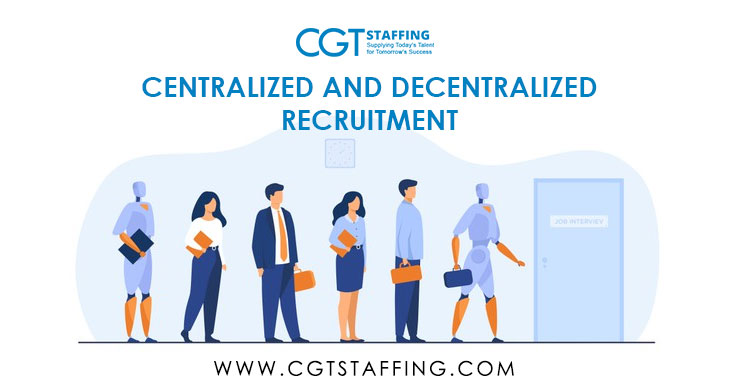Businesses need skilled workers to remain sustainable. That’s why the recruitment function is a core business need, no matter what the size of an organization. Talent acquisition strategies have evolved as businesses experience successes and failures. The process has increasingly become more sophisticated than a simple job advert in the newspapers. These days, businesses are reluctant to make a bad hire and inflate their employee turnover and workforce management costs.
A bad hire can have far-reaching effects. Therefore, most employers prefer to do it right the first time around. Over time and through constant refinement, most businesses follow either a centralized recruitment process or a decentralized one. Which one should you choose? Read on to get a better idea of what they involve.
Table of Contents
A Foreword on Modern Recruitment Models
Centralized and decentralized recruitment is widely in use today. Both are effective in certain ways and could be lacking in others. Different recruitment models are often successful, but they aren’t the only variables that impact successful recruitment. There are others, such as how effective a firm’s in-house recruiters and an associated staffing agency are, and how conducive the workplace culture is to retaining workers. There are many steps that business owners and hiring managers can take to improve their recruitment process. But choosing the right model for their recruitment needs is usually a good step.
The discussion around centralized vs decentralized staffing is always on the table when making decisions in reference to business requirements. It may not always be possible to state beforehand which one would be the best fit for a specific business, however, it is always possible to test out either. Of course, managers should still have a firm idea of what model to follow, or what changes to pitch to their recruitment officers. Read on to take a closer look at each model.
Centralized Recruiting as a Hiring Model
Centralized talent acquisition and human resource management have been in use for a long time in corporations and smaller businesses alike. The model is formulated around a single system that all hiring needs are funneled through. All business staffing needs, from cybersecurity staffing to manufacturing recruitment would need to pass through this system. The centralized approach isn’t just limited to human resources either. Most businesses tend to have centralized IT departments, centralized inventory management systems, and centralized ERP systems as well.
It only makes sense to apply the same philosophy to recruitment and human resource management. The centralized HR department would follow a defined set of rules and standards. At the same time, all members involved in recruitment would share the same central values and follow the same procedures every time.
The Pros and Cons of a Centralized Model
Centralized recruitment models are great for several valid reasons. The biggest one, by far, is improved and standardized hiring quality. The shared and centralized values ensure a consistent approach to each hiring need. At the same time, with a smooth working system, you need fewer employees deployed to the recruitment process. Therefore, the costs of engaging a successful hire will go down considerably.
However, there are also certain obvious disadvantages to this approach. A multinational company with a presence in diverse regions would find this approach to be counterproductive, for example. The inherent rigidity in the process may slow down hiring workers from different cultures or backgrounds. It may also make it very difficult to source skilled workers in a region that the hiring model wasn’t built for.
Decentralized Hiring
While both have the same ultimate goal, the decentralized recruitment process differs from the centralized model in the approach it takes to execute a successful hire. The process involves delegating the hiring decision to the team, department, or division that the new hire would be working. So, your mortgage team manager would also act as a mortgage recruiter for immediate staffing needs, your IT manager would work on the hire of a new information security officer, and so on.
This approach addresses a glaring flaw in the centralized approach: it is almost impossible to measure worker aptitude or assess their potential with a standardized test. Instead, it chooses people who already have a working knowledge of what a role requires to judge whether a prospective candidate can fill it.
The Pros and Cons of Decentralized Recruitment
While effective, the decentralized approach also doesn’t work well in all businesses or hiring environments. It involves tying down valuable resources in the recruitment process to increase hiring success. It can disrupt normal workflows and workforce management in the interim. However, in many cases, it can prove to be the best approach to a successful and productive hire.
For example, by taking all hiring stakeholders on board, a more refined and targeted approach can be taken. Managers who will work directly with the new worker will likely already have a strong idea about what kind of employee they need. This lowers the chances of a bad hire as well as increases the likelihood of a strong working relationship ahead.
FAQs
What is centralization vs decentralization?
Centralization basically revolves around the concept of having the senior management make all important decisions of an organization with utmost authority and power. On the contrary, decentralization leaves the decision-making power in the hands of the organization’s functional-level management.
What is centralized recruitment?
Centralized staffing refers to decisions regarding recruitment being made by an organization’s human resource department solely. From overseeing to standardizing, this department takes charge of all the hiring processes.
What is decentralized recruitment?
Instead of giving authority to the central/single unit or team responsible for corporate hiring, the decentralized staffing model gives this power to the local recruiting managers for teams or departments. Through this process, the potential candidates get a more customized experience.
What is a centralized and decentralized system?
In a centralized system setting goals, strategic planning, talent deployment, and budgeting are all handled by a single unit or senior leadership. In decentralized systems, the decision-making authority is shared among multiple teams or individuals.
